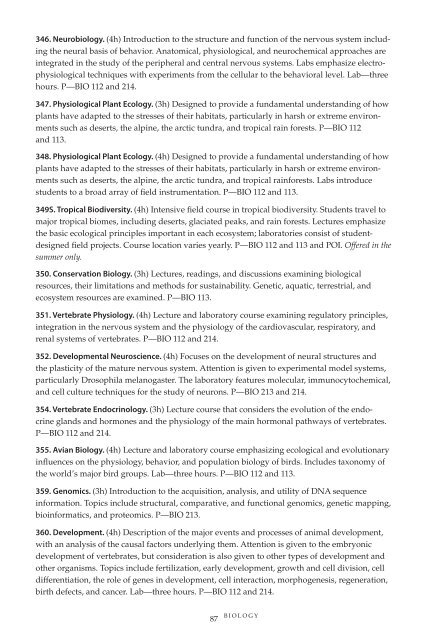theundergraduateschoo ls - Wake Forest University
theundergraduateschoo ls - Wake Forest University
theundergraduateschoo ls - Wake Forest University
You also want an ePaper? Increase the reach of your titles
YUMPU automatically turns print PDFs into web optimized ePapers that Google loves.
346. Neurobiology. (4h) Introduction to the structure and function of the nervous system including<br />
the neural basis of behavior. Anatomical, physiological, and neurochemical approaches are<br />
integrated in the study of the peripheral and central nervous systems. Labs emphasize electrophysiological<br />
techniques with experiments from the cellular to the behavioral level. Lab—three<br />
hours. P—BIO 112 and 214.<br />
347. Physiological Plant Ecology. (3h) Designed to provide a fundamental understanding of how<br />
plants have adapted to the stresses of their habitats, particularly in harsh or extreme environments<br />
such as deserts, the alpine, the arctic tundra, and tropical rain forests. P—BIO 112<br />
and 113.<br />
348. Physiological Plant Ecology. (4h) Designed to provide a fundamental understanding of how<br />
plants have adapted to the stresses of their habitats, particularly in harsh or extreme environments<br />
such as deserts, the alpine, the arctic tundra, and tropical rainforests. Labs introduce<br />
students to a broad array of field instrumentation. P—BIO 112 and 113.<br />
349S. Tropical Biodiversity. (4h) Intensive field course in tropical biodiversity. Students travel to<br />
major tropical biomes, including deserts, glaciated peaks, and rain forests. Lectures emphasize<br />
the basic ecological principles important in each ecosystem; laboratories consist of student-<br />
designed field projects. Course location varies yearly. P—BIO 112 and 113 and POI. Offered in the<br />
summer only.<br />
350. Conservation Biology. (3h) Lectures, readings, and discussions examining biological<br />
resources, their limitations and methods for sustainability. Genetic, aquatic, terrestrial, and<br />
ecosystem resources are examined. P—BIO 113.<br />
351. Vertebrate Physiology. (4h) Lecture and laboratory course examining regulatory principles,<br />
integration in the nervous system and the physiology of the cardiovascular, respiratory, and<br />
renal systems of vertebrates. P—BIO 112 and 214.<br />
352. Developmental Neuroscience. (4h) Focuses on the development of neural structures and<br />
the plasticity of the mature nervous system. Attention is given to experimental model systems,<br />
particularly Drosophila melanogaster. The laboratory features molecular, immunocytochemical,<br />
and cell culture techniques for the study of neurons. P—BIO 213 and 214.<br />
354. Vertebrate Endocrinology. (3h) Lecture course that considers the evolution of the endocrine<br />
glands and hormones and the physiology of the main hormonal pathways of vertebrates.<br />
P—BIO 112 and 214.<br />
355. Avian Biology. (4h) Lecture and laboratory course emphasizing ecological and evolutionary<br />
influences on the physiology, behavior, and population biology of birds. Includes taxonomy of<br />
the world’s major bird groups. Lab—three hours. P—BIO 112 and 113.<br />
359. Genomics. (3h) Introduction to the acquisition, analysis, and utility of DNA sequence<br />
information. Topics include structural, comparative, and functional genomics, genetic mapping,<br />
bioinformatics, and proteomics. P—BIO 213.<br />
360. Development. (4h) Description of the major events and processes of animal development,<br />
with an analysis of the causal factors underlying them. Attention is given to the embryonic<br />
development of vertebrates, but consideration is a<strong>ls</strong>o given to other types of development and<br />
other organisms. Topics include fertilization, early development, growth and cell division, cell<br />
differentiation, the role of genes in development, cell interaction, morphogenesis, regeneration,<br />
birth defects, and cancer. Lab—three hours. P—BIO 112 and 214.<br />
B I O L O G Y<br />
87






